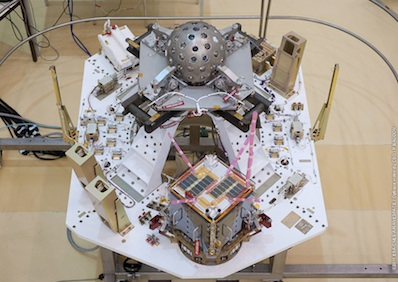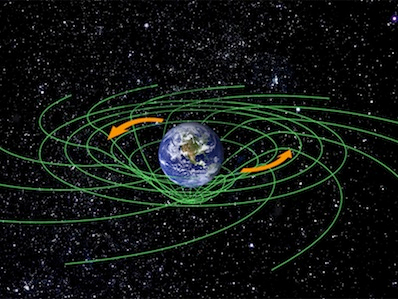Europe's 1st Vega Rocket Will Launch Satellite to Map Space-Time Warp

Scheduled for launch from French Guiana on Monday, Europe's first lightweight Vega rocket is packed with nine small research satellites, including a unique Italian craft designed to help make an elusive accurate measurement of a central tenet of Albert Einstein's theory of general relativity.
The 98-foot-tall booster is due for liftoff in a two-hour launch window opening at 1000 GMT (5 a.m. EST) Monday. The four-stage launcher, developed with Italian leadership, will make its first flight from the Guiana Space Center, a European-run spaceport in French Guiana.
The Vega rocket will deploy its nine payloads at different altitudes, first releasing the Laser Relativity Satellite about 55 minutes after launch in a circular 901 mile-high orbit with an inclination of 69.5 degrees.
Another firing by the Vega's fourth stage, powered by a Ukrainian liqiud-fueled engine, will reduce the altitude of the orbit's low point to 217 miles before deploying Italy's ALMASat 1 technology demonstration satellite and seven two-pound CubeSats built by learning institutions across Europe.
The Vega's mission will conclude 81 minutes after launch.
Officials selected LARES as the main passenger for the rocket's qualification flight, which aims to prove Vega's flight and ground systems before it is entrusted with more costly payloads on subsequent missions. [Photos: Meet Vega, Europe's New Rocket]
Carved out of a single ball of tungsten, LARES is covered with 92 laser retroreflectors, allowing a network of ranging stations around the world to track the spherical satellite in orbit.
Get the Space.com Newsletter
Breaking space news, the latest updates on rocket launches, skywatching events and more!
By bouncing laser signals off reflectors on LARES, scientists can precisely compute its position in space. After comparing the actual location of LARES against predictions, researchers can measure the frame-dragging effect, part of Einstein's theory of general relativity which states that a rotating mass can distort space-time around it.
"Imagine the Earth as if it were immersed in honey. As the planet rotates, the honey around it would swirl, and it's the same with space and time," said Francis Everitt, a Stanford University researcher who led the science team for NASA's Gravity Probe B mission, which confirmed the frame-dragging, or Lense-Thirring, effect at 37.2 milliarcseconds with a margin for error of about 19 percent.
Gravity Probe B's results were announced in May 2011.
The frame-dragging effect manifests itself in minuscule changes in the orbits of satellites. Scientists observed two precursors to LARES, named LAGEOS 1 and LAGEOS 2, over several years to determine their orbital planes shifted 6 feet per year in the direction of Earth's rotation.
The LAGEOS tracking, coupled with a precise Earth gravity model, produced an estimation of the frame-dragging effect at 99 percent of the value predicted under general relativity. The joint U.S.-Italian LAGEOS mission ultimately measured the effect with an accuracy of about 10 percent.

The objective of LARES is to refine the real effect of frame-dragging with an accuracy approaching 1 percent, according to the Italian space agency, which is funding the mission.
Better data on the frame-dragging effect around Earth will help astrophysicists study distant black holes, neutron stars and active galactic nuclei, whose immense gravity creates much stronger warping of space-time. [6 Weird Facts About Gravity]
LARES was designed at Sapienza University of Rome and built by Carlo Gavazzi Space. The passive satellite measures 14.8 inches in diameter and has a mass of about 881 pounds, according to ESA.
The satellite is mounted on a support structure housing a camera and avionics to command the separation of Vega's secondary payloads. The avionics, derived from technology used in Formula 1 auto racing, will acquire data from a suite of environmental and acceleration sensors measuring the performance of the Vega launcher.
ALMASat 1, Vega's second largest payload, was developed by the University of Bologna. The 27.5-pound craft will test technologies and a low-cost satellite bus for future Earth observation missions.
Loaded inside three PPOD deployers, the Vega launcher's seven CubeSat passengers include:
- e-St@r - Developed by the Polytechnics Institute of Turin in Italy, e-St@r willtest an active determination and control subsystem for 3-axis control as well as a set of commercial components and materials.
- Goliat - Developed by the University of Bucharest in Romania, Goliat will perform Earth imaging with a 3-megapixel digital camera and conduct measurements of radiation and micrometeoroids in low-Earth orbit. This is Romania's first satellite.
- MaSat 1 - Developed by the Budapest University of Technology and Economics in Hungary, MaSat 1 will demonstrate a power conditioning system, a transceiver and an onboard data handling system. This is Hungary's first satellite.
- PW-Sat 1 - Developed by the Warsaw University of Technology in Poland, PW-Sat 1 will deploy a solar sail as a drag augmentation device in order to accelerate the removal of picosatellites at the end of their missions. This is Poland's first satellite.
- Robusta - Developed by the University of Montpellier in France, Robusta will study the effect of radiation on electronic components based on bipolar transistors for comparison with its own degradation models.
- UniCubeSat GG - Developed by the GAUSS astrodynamics group of the Sapienza University of Rome, UniCubeSat GG will deploy two booms to demonstrate gravity-gradient stabilization on a picosatellite. Each boom will carry a solar panel at its end to generate electrical power.
- Xatcobeo - Developed by the University of Vigo in Spain, Xatcobeo will test a software-defined reconfigurable radio and an ionizing radiation measurement system. It will also test a solar panel deployment system.
Editor's Note: The Vega launch can be watched live via ESA's webcast here.
Copyright 2012 SpaceflightNow.com, all rights reserved.

Join our Space Forums to keep talking space on the latest missions, night sky and more! And if you have a news tip, correction or comment, let us know at: community@space.com.
Stephen Clark is the Editor of Spaceflight Now, a web-based publication dedicated to covering rocket launches, human spaceflight and exploration. He joined the Spaceflight Now team in 2009 and previously wrote as a senior reporter with the Daily Texan. You can follow Stephen's latest project at SpaceflightNow.com and on Twitter.










